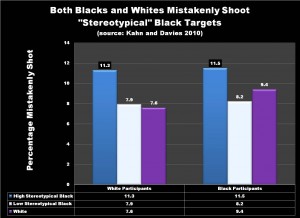Some influential social theories predict a strong link between criminal punishment and unemployment rates, but the research usually paints a more complicated picture. The picture above, taken from a new article with Ryan King and Mike Massoglia, doesn’t seem so complicated by comparison. I won’t belabor all the details, but one basic idea was to ask whether the United States deported more people for criminal behavior when unemployment was on the rise. Sure enough, unemployment and criminal deportation tracked each other very closely from about 1941 to 1986 (since 1987, deportations have more closely tracked the steep rise in incarceration). The chart shows year-to-year changes in each measure, with the spikes in deportation (the solid line) corresponding to similar spikes in unemployment (the dashed line). Of course, no picture is that simple; there’s always a real danger that such correlations could be due to chance or to factors we failed to consider. At minimum, though, a picture like this could make it a little tougher to dismiss the old idea that punishment might have something to do with economic conditions.
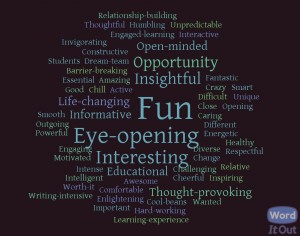 My first Inside-Out class in a juvenile correctional facility is quickly drawing to a close on our 10 week quarter system. The word cloud featured here is how the students described the experience. I asked each of the 27 students (from OSU and from the facility) to write three words that described our class, and this is what they came up with. Fun, eye-opening, interesting, thought-provoking…I’ll take it! Those are pretty good adjectives to describe any college class.
My first Inside-Out class in a juvenile correctional facility is quickly drawing to a close on our 10 week quarter system. The word cloud featured here is how the students described the experience. I asked each of the 27 students (from OSU and from the facility) to write three words that described our class, and this is what they came up with. Fun, eye-opening, interesting, thought-provoking…I’ll take it! Those are pretty good adjectives to describe any college class.
Along with Sarah Ferrer’s guest editorial in The Oregonian newspaper, there have been other interesting products from this short class. First, we’ve added on to the We are the 1 in 100 tumblr site that was started in last fall’s class in the Oregon State Penitentiary.
Next, several of this quarter’s outside students were featured in a story in Oregon State University’s student newspaper, The Daily Barometer. In the story, they share their enthusiasm for the experience and the group service-learning projects they are working on with the inside students. The last lines of the story:
The students are all very grateful to have taken part in the class and encourage other students to take advantage of it in future terms. “This class is a once-in-a-lifetime opportunity,” Settelmeyer said. “It does a great job of sparking student interest in making a difference and walks us through starting to do just that.”
Finally, I’m working again the with the Think Out Loud crew from Oregon Public Radio. They are going to be taping their hour-long show tonight in the youth facility with my class. The show is scheduled to air tomorrow morning at 9:00. It should be available on OPB’s website (to stream or download as a podcast) shortly after. The major question that emerged from our pre-show interviews, “From inside Hillcrest Youth Correctional Facility we ask inmates: what is happening in prison to make them better citizens when they are released?” I’m hoping for a fun, eye-opening, interesting, thought-provoking (sound familiar?) and very positive show.
So, for one brief class, I think we’ve done our part for public criminology and bringing attention to issues surrounding prisons and juvenile correctional facilities and their impacts on both those inside the walls and on the larger community. I’ll be sorry to see this class end, but I am looking forward to a long and rewarding relationship with Hillcrest Youth Correctional Facility and the Oregon Youth Authority.
 Sarah Ferrer, a student in my current Inside-Out class, had a guest editorial published in The Oregonian newspaper this week. Writing a letter to an editor or to a state representative is an assignment in the class, submitting it is not. Sarah went above and beyond my expectations when she wrote not just a letter, but an editorial, and had it accepted by Oregon’s largest newspaper. She begins by writing:
Sarah Ferrer, a student in my current Inside-Out class, had a guest editorial published in The Oregonian newspaper this week. Writing a letter to an editor or to a state representative is an assignment in the class, submitting it is not. Sarah went above and beyond my expectations when she wrote not just a letter, but an editorial, and had it accepted by Oregon’s largest newspaper. She begins by writing:
I am not a criminologist. I am a biochemistry and biophysics honors student at Oregon State University. Over the past term, I have participated in a criminology class that has given me the opportunity to explore the impact incarceration has on communities. Here’s the catch: More than half of the students enrolled in the class are serving time at Hillcrest Youth Correctional Facility. I have the unique experience of learning about incarceration from the incarcerated. My goal here is not to give an expert’s opinion (for I am not one), but to share some of the things I have learned and to encourage readers to educate themselves on the implications of mass incarceration.
She then goes on to use information from class materials, particularly Todd Clear’s Imprisoning Communities, to highlight the inequities and inefficiencies in our current system and to push for prison reform.
To this point there are 97 comments following her editorial; it’s the third most active opinion piece over the last 7 days. Many of the comments are very harsh and suggest that Sarah is too young and naive to deserve a voice in the conversation, or they dismiss her as being another “bleeding heart” duped and manipulated by her criminal classmates.
To her credit, Sarah knew full well that she was opening herself to public critique and nastiness when she submitted her editorial. And she has engaged in thoughtful, reasoned debate with the comments, clarifying points and offering additional information and perspective. All in all, I am very proud of her for sparking this important discussion and engaging in public debate over prison reform. Seeing an undergraduate student make this kind of educational effort makes me very hopeful that today’s students will lead the charge toward positive change, more caring communities, and a brighter future for us all.
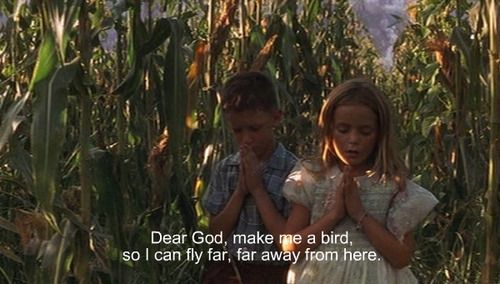 I spent part of my evening in a juvenile correctional facility last night with a group of smart, articulate young women serving time for a variety of offenses and literally growing up while behind bars. I spend quite a bit of my time teaching and volunteering in prisons and juvenile facilities, and I always enjoy talking with incarcerated young people. While most have made some very serious mistakes, I very often come away impressed with their thoughtfulness and their resilience.
I spent part of my evening in a juvenile correctional facility last night with a group of smart, articulate young women serving time for a variety of offenses and literally growing up while behind bars. I spend quite a bit of my time teaching and volunteering in prisons and juvenile facilities, and I always enjoy talking with incarcerated young people. While most have made some very serious mistakes, I very often come away impressed with their thoughtfulness and their resilience.
What particularly struck me last night was when several of the girls spoke about their dreams and fantasies about flying. In doing so, they evoked – and perfectly quoted – the line from Forrest Gump, where young Jenny is praying to God to help her escape her father’s house and his abuse: “Dear God, make me a bird so that I can fly far, far, far away from here…Dear God, make me a bird so that I can fly far, far, far away from here….”
I’d seen the movie years ago, but that line never held the same resonance for me. Lucky me. I was fortunate enough to grow up cared for and loved, and as a child I never had to worry about protecting myself or getting out of the way of harm. I wonder how many incarcerated youth can say the same? How many children have their innocence destroyed and are never able to find a legal escape?
I think part of the reason these issues of youth, pain, and longing are lingering in my mind is because one of my favorite songs at the moment is “Take Me Away” which shares some of the sentiment of the girls’ discussion and Jenny’s prayer. Some of the lyrics (written by Scott Alan):
Let me climb to the top
Of the highest mountain peak
Let me scream at the top of my lungs
Until I can no longer speak
Can’t remember the last time
I said live and let things be
And it’s just been way too long
Since I felt alive and free
So I’ll sail away
Until I reach the sea
So I’ll soar the sky
Until I feel the breeze
I am ready to return
To the place I last felt stillness
To return to the heart
I had when I was five
Where the only thing that mattered
Was making colors I can paint with
I’m much too young
To let my life hang out to dry
So I’ll sail away
Until I reach the sea
And I’ll soar the sky
Until I feel the breeze
If you have not heard this song, do yourself a favor and take 4 minutes to listen to Hadley Fraser sing it – his performance is absolutely brilliant:
 In the wake of Trayvon Martin’s killing, Jonathan Capehart relayed a couple of the “it ain’t right, it ain’t fair, but that’s the way it is” lessons he was taught in youth: don’t run in public, lest someone think you’re suspicious; and, don’t run while carrying anything in your hands, lest someone think you stole something.
In the wake of Trayvon Martin’s killing, Jonathan Capehart relayed a couple of the “it ain’t right, it ain’t fair, but that’s the way it is” lessons he was taught in youth: don’t run in public, lest someone think you’re suspicious; and, don’t run while carrying anything in your hands, lest someone think you stole something.
I’ve followed and admired Mr. Capehart’s clear and powerful writing since we met in the US-Japan Leadership Program. We don’t know each other well, but I happened to have this picture of us onscreen when I came across his Washington Post op-ed and appearance on MSNBC. No, I’m not a stalker. I’d been prepping lecture slides for an upper-division sociology class, using the photo as a representation of “social drinking” as a respectable and sophisticated activity for upwardly mobile young adults.*
And there’s the rub. When a black male is running down the street, we don’t tend to notice his respectability, sophistication, or upward mobility — let alone his youth or innocence. Yet the other four people in the picture can generally run with impunity, donning hoodies if we wish. Even those who resist ideas like “white privilege” can appreciate such simple and basic injustices, especially when writers as talented as Jonathan Capehart help bring them to light.
*As you might guess, I then follow-up with a few pictures portraying alcohol use in a less positive light.
 Whenever I get to teach a criminology seminar, I always assign a little James Q. Wilson in the very first week. Not his influential writing on policing, mind you, but his powerful 1975 critique of academic criminology in Thinking about Crime. With his death this week, I’m Thinking about Wilson. Though we came from very different places, his work reshaped my approach and orientation as a social scientist, public criminologist, and TSP editor.
Whenever I get to teach a criminology seminar, I always assign a little James Q. Wilson in the very first week. Not his influential writing on policing, mind you, but his powerful 1975 critique of academic criminology in Thinking about Crime. With his death this week, I’m Thinking about Wilson. Though we came from very different places, his work reshaped my approach and orientation as a social scientist, public criminologist, and TSP editor.
In that book, Professor Wilson argued powerfully and convincingly that (a) we lacked strong evidence about the most critical questions about crime policy; and, (b) we then fell back on our views as private citizens when we were consulted as crime experts:
[W]hen social scientists were asked for advice by national policy-making bodies they could not respond with suggestions derived from and supported by their scholarly work … as a consequence such advice as was supplied tended to derive from their general political views as modified by their political and organizational interaction with those policy groups and their staffs (p. 49) … I am confident that few social scientists made careful distinctions, when the chips were down, between what they knew as scholars and what they believed as citizens (p. 68).
During my first heady days of graduate school, I was simultaneously encountering similar ideas from Max Weber. But the spot-on power of James Q. Wilson’s polemic hit me like a line drive to the chest. I immediately recognized myself as the sort of mushy-headed liberal who sought a Ph.D. credential as a bully pulpit for offering well-intended but baseless policy pronouncements.
After digesting Thinking about Crime, though, I resolved to conduct the sort of research that would provide a sound evidentiary base for policy. I cannot claim complete fidelity to this approach (nor, I suppose, could Professor Wilson), but it led me to research questions where I could make myself useful (e.g., employment and crime, felon disenfranchisement).
I’ve also taken to heart Professor Wilson’s admonition to distinguish the research-based opinions we present as experts from those derived from our private beliefs as citizens. My friends and students recognize this as the “hat” issue: I’ll offer a private opinion on anything from Tony Lama boots to the Fed’s quantitative easing policy, but I try to be a little more circumspect when wearing the expert hat (which happens to be a brown fedora).
While I’ll stipulate to some important “Yeah, buts” here (recognizing instances where we all stray from our high-minded ideals), Thinking about Crime still functions as both critique and call to action — for individual careers and for whole disciplines. Engaging pressing policy questions can give added meaning and purpose to our work. But such engagement is most legitimate and authoritatitive when it is founded on a real base of knowledge, interpretation, and analysis.
The good news is that “what we know as scholars” has changed much since Professor Wilson wrote in 1975. Social scientists are today assembling a more powerful, relevant, and solidly credible evidentiary base; we are thus better able to offer policy suggestions “derived from and supported by our scholarly work,” while also bringing much-needed global and historical perspectives to contemporary debates that would otherwise be framed too narrowly.
The ongoing challenge, for our careers and our disciplines, is to find new and effective ways to bring this knowledge and perspective to light. Hence, our mission at TSP: to bring social scientific knowledge and information to broader public visibility and influence. And regardless of your opinion on James Q. Wilson’s scholarship or his political inclinations, he stood as a highly visible and remarkably influential public intellectual.
photo by lokarta (creative commons license)
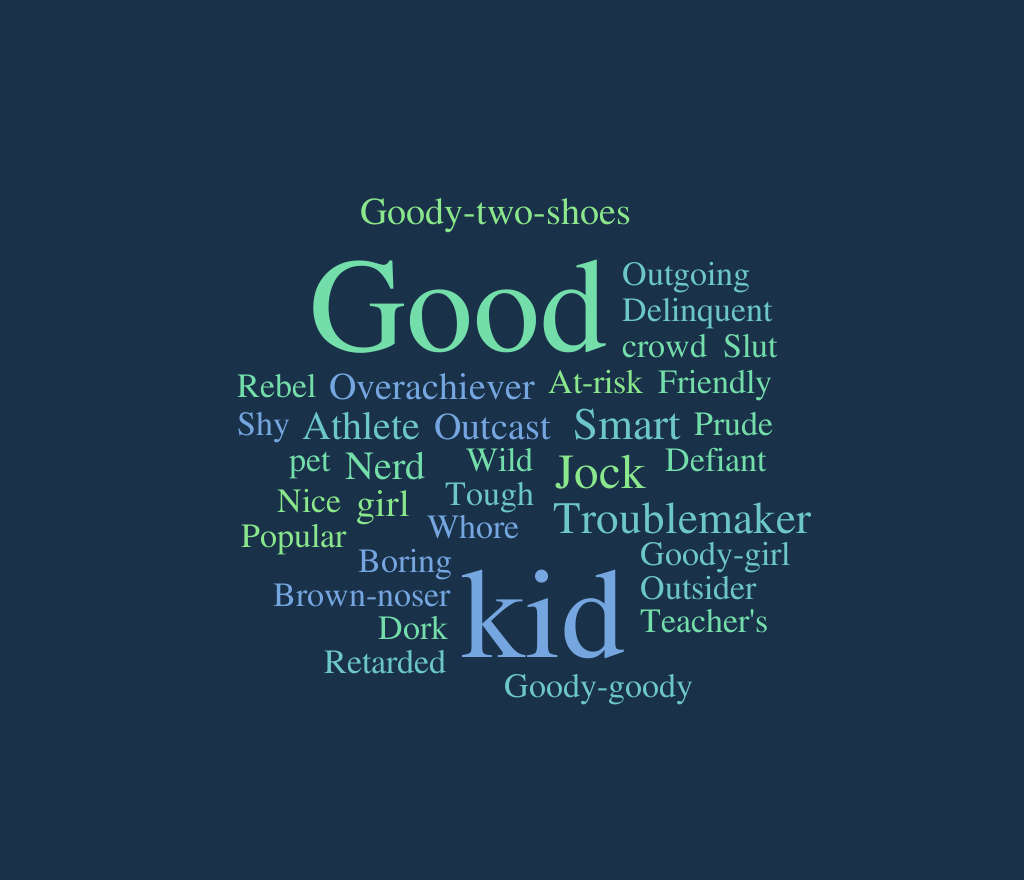 I asked my Juvenile Delinquency students to write short essays reflecting on the labels that had been applied to them as they were growing up. As I read the essays, I took note of the words they used to explain how other people saw and described them, and I created the word cloud above (worditout.com) .
I asked my Juvenile Delinquency students to write short essays reflecting on the labels that had been applied to them as they were growing up. As I read the essays, I took note of the words they used to explain how other people saw and described them, and I created the word cloud above (worditout.com) .
It should come as no surprise that senior level college students were generally viewed as “good kids” – they are the success stories of their junior high and high schools. The phrase “good kid” came up repeatedly, as did variations such as “good girl”, “goody-two-shoes”, “teacher’s pet”, etc. A number of students described themselves as “athletes” or “jocks”, and a few students felt like “outcasts” or “outsiders”. Several felt like their teachers and other adults viewed them as “troublemakers” which often brought more scrutiny and limited their conventional opportunities. Most problematic were the labels “slut”, “retarded”, and “whore” – all characterizations which are hurtful just to write, let alone be weighed down by.
For the second half of their essay, I asked the students to imagine what their lives would have been like if they had been processed through the juvenile justice system and formally labeled delinquent (or, conversely, to imagine the opposite for those who lived the experience of formal labeling). It is a good chance for them to look back on their lives and think about their statuses, relationships and opportunities. And it reminds us all of the power of labels. Please, choose your words wisely.
Reading press reports on school bullying got me thinking about the limits of my own expertise and about how social scientists can sometimes contribute to debates even when we are not experts. I always tell graduate students to imagine their expertise as a series of concentric circles radiating outward from the core stuff they know best. They should be grade-A champion world authorities on their dissertation topics, possess solid expertise in their specific areas of research and teaching, and they should know enough about methods and evidence to evaluate claims made by others in the broader fields in which they work. But even when we are not experts, we can always raise questions.
The question I’d raise here is simply whether getting tough on bullying will worsen racial disparities in education. Bullying is a hot issue these days, with a steady drumbeat of legislation and opinion pieces urging us to “strengthen” anti-bullying laws. At the same time, there is deep and abiding concern about closing the gaps in education. Now I can’t claim any real expertise in bullying or in educational attainment, but I can offer a respectful heads-up to policy folks as they craft new anti-bullying laws and practices. How are you thinking about their likely racial impact? I ask because stricter regulation of a broad set of behaviors like bullying could worsen racial disparities in school discipline.
I’ll explain my rationale for this heads-up below, but I really want to make the more general point that sometimes social scientists can contribute to public debates even when we aren’t the leading experts on a topic. We have to be more careful and guarded in our claims, of course, when our expertise is limited to reading and teaching what others have written. Still, we can provide a service even when we raise questions or help people “connect the dots” in a useful way. My approach is usually to just point to the “dots” that I’ve found convincing and to ask questions about whether and how the policy action being considered might take account of them.
I base my bullying heads-up on two related lines of social science research. The first concerns implicit racial bias in perceptions of threat and dangerousness. The chart below is taken from a 2010 piece by Kimberly Kahn and Paul Davies, who showed that both White and African American study participants were more likely to assume people with stereotypically African American features had guns in a split-second shoot/don’t shoot computer simulation. Both Whites and African Americans mistakenly shot targets with darker skin, broader noses, and fuller lips about 11 percent of the time, relative to 8 or 9 percent of the time for White targets and “low-stereotypical” African American targets. This sort of pattern is evident in a lot of research on “implicit bias,” where whites tend to be perceived as more safe and less threatening than (otherwise identical) African Americans. My sense from this research is that actions by darker-skinned students might be more likely to be perceived and punished as bullying than when the same actions are taken by lighter-skinned students.
The second “dot” is that most of the self-report studies I’ve seen also show racial differences in self-reported bullying behavior. The chart below is taken from a 2007 study in the Journal of Adolescent Health by Aubrey Spriggs and colleagues. According to their analysis of a nationally representative sample of 6th to 10th graders, African American children were significantly less likely than White children to report they were targets of bullying and significantly more likely to report engaging in bullying behaviors themselves.
About 17 percent of African American kids self-reported physical bullying, relative to 15 percent of Hispanic youth, 11 percent of Whites, and 12 percent of those of other groups. The targeting or victimization numbers go in the other direction, with 12 percent of African Americans reporting being physically bullied, relative to 15 percent of whites. The same patterns seem to hold for other types of bullying (verbal, relational, and cyber) as well.
Experts on bullying can surely provide a better account of these figures than I can, but it looks to me as though enforcing vague bullying rules more strictly could worsen racial disparities in school discipline and, perhaps, educational attainment. I don’t know enough about bullying or schools to make strong policy recommendations, but it seems there is enough evidence here to at least put the question of racial impact to those charged with making or enforcing new rules. A small but significant difference in self-reported bullying combined with implicit bias in enforcing bullying rules could lead to pronounced disparities. That doesn’t mean anyone should ignore bullying, of course, it just means that we might consider steps to help reduce or mitigate bias when we change the rules.
One proposed Minnesota bill would define bullying as conduct “so severe, pervasive or objectively offensive that it substantially interferes with the student’s educational opportunities,” or places the student in “actual and reasonable” fear of harm, or substantially disrupts school operations. This seems to set a pretty high bar, which would appear to be racially neutral — unless, of course, students, teachers, and administrators are already more afraid of darker-skinned students. If so, there is some evidence to suggest they will be quicker to pull the trigger in suspending or expelling such students.
CNN’s Anderson Cooper has devoted several recent crime and punishment reports to the pardons meted out by former Mississippi governor Haley Barbour. In several segments, Mr. Cooper seemed incredulous that convicted murderers were allowed to serve as “trustees” in the governor’s mansion prior to their release. In one report, for example, he and attorney Jeffrey Toobin dismissed Governor Barbour’s claim that murderers convicted of a single crime of passion were somehow better suited for such positions than inmates serving time for lesser offenses.
I will not comment here on the uses and abuses of the trustee (or “trusty”) system, except to note that the practice was once widespread but waned considerably after the prisoners’ rights revolution that began in the 1960s. Instead, I’m here to explain why Governor Barbour and his staff preferred employing convicted murderers rather than, say, convicted car thieves.
The chart below is taken from an excellent large-scale Bureau of Justice Statistics recidivism study (Langan and Levin 2002). Overall, 67.5 percent of prisoners were rearrested within 3 years of their release and 25.4 percent were returned to prison for committing new offenses (others were returned to prison for violating the terms of their release). If you click on the chart, you can see that people convicted of homicide have the lowest rate of recidivism as measured by rearrest — 40.7 percent — and the second lowest rate of return to prison for a new offense (10.8 percent). At the other end of the chart, about 79% of those convicted of motor vehicle theft were rearrested and about 31 percent were returned to prison after being convicted of a new crime.
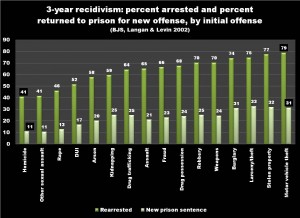 This doesn’t mean that a 20-year-old murderer is less dangerous than a 20-year-old car thief, of course. It just means that by the time we see fit to release people convicted of homicide, they are unlikely to pose a significant threat to public safety. Many have spent decades in prison and are much older than other inmates when they are finally freed. Convicted murderers make good candidates for pardons precisely because their sentences are soooo long relative to the risk that many of them pose at the tail-end of those sentences.
This doesn’t mean that a 20-year-old murderer is less dangerous than a 20-year-old car thief, of course. It just means that by the time we see fit to release people convicted of homicide, they are unlikely to pose a significant threat to public safety. Many have spent decades in prison and are much older than other inmates when they are finally freed. Convicted murderers make good candidates for pardons precisely because their sentences are soooo long relative to the risk that many of them pose at the tail-end of those sentences.
But aren’t those convicted of killing especially likely to kill again? I mean, a 10.8 percent recidivism rate would be awful if half of those offenses turned out to be new murders. Contrary to all we’ve learned from Quentin Tarantino movies, however, homicide offenders tend not to specialize in killing.
The chart below uses odds ratios to represent the degree of specialization among people convicted of various crimes. Here, the 1.4 for homicide is the ratio of the odds that a homicide offender will be rearrested for another homicide (that’s the numerator in the ratio) relative to the odds that prisoners released for other offenses will be arrested for a homicide (that’s the denominator). You can see some evidence of specialization among those convicted of motor vehicle theft, where the odds of rearrest for a new auto theft are about 1.9 times greater than those for non-car thieves (2.9-1=1.9). There is an even greater degree of specialization for rape and other sexual offenses, with odds ratios of 4.2 and 5.9, respectively, corresponding to rates of new sex offenses that are 3-to-5 times higher than those for people convicted of non-sex crimes. For homicide, however, the odds ratio of 1.4 suggests comparatively little specialization. 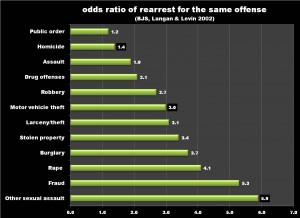
I might also add that a great proportion of homicides are “cleared” by arrest, relative to the other offenses on the list, so it doesn’t seem likely that rampant homicide recidivism is somehow going undetected by the system.
In short, there is much evidence that recidivism rates for people convicted of homicide tend to be particularly low. While it may be politically unpopular to pardon convicted murderers or to place them in positions of trust, they tend to do well when, at long last, they are afforded such opportunities.
 Criminologists Al Blumstein and Kiminori Nakamura offer a powerful New York Times op-ed this week, arguing that “stale criminal records” should expire when they can no longer distinguish criminals from non-criminals.
Criminologists Al Blumstein and Kiminori Nakamura offer a powerful New York Times op-ed this week, arguing that “stale criminal records” should expire when they can no longer distinguish criminals from non-criminals.
But this isn’t just a couple of bleeding heart academics advocating on behalf of a stigmatized group — there’s a solid research foundation supporting the argument. Several smart and creative studies have now followed people arrested or convicted of crimes to watch how long it takes before a criminal’s risk of a new offense drops to the point that it is indistinguishable from those with no record of past crimes.
Several teams of social scientists have designed really elegant studies to answer this important question. Most use some variant of event history or survival analysis — a semi-fancy but straightforward set of statistical tools. Based on their own research, Blumstein and Nakamura now conservatively estimate the “redemption time” at 10 to 13 years. Megan Kurlychek, Bobby Brame, and Shawn Bushway came up with about a 6-year window using somewhat different data and methodology in 2006.
While the specific “time-to-no-crime” varies across studies, the best evidence is now calling into question standard “lifetime” bans on employment, voting, and other rights and privileges. This doesn’t mean that the laws will be changed or even that they should be changed. But it does show how good social science can challenge old assumptions and inject much-needed evidence into public debates. And, for those of us who like to put our semi-fancy statistics to good purpose, the op-ed and the research beneath it offer a fine example of public scholarship.


